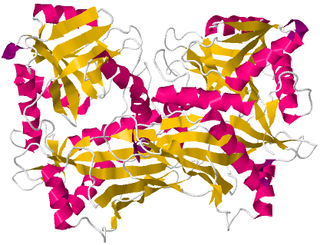
Valproate (VPA) and its valproic acid, sodium valproate, and valproate semisodium forms are medications primarily used to treat epilepsy and bipolar disorder and prevent migraine headaches. They are useful for the prevention of seizures in those with absence seizures, partial seizures, and generalized seizures. They can be given intravenously or by mouth, and the tablet forms exist in both long- and short-acting formulations.
Depressants, or central depressants, are drugs that lower neurotransmission levels, or depress or reduce arousal or stimulation in various areas of the brain. Depressants are also colloquially referred to as "downers" as they lower the level of arousal when taken. Depressants do not change the mood or mental state of others. Stimulants, or "uppers," increase mental or physical function, hence the opposite drug class from depressants are stimulants, not antidepressants.

Gabapentin, sold under the brand name Neurontin among others, is an anticonvulsant medication primarily used to treat partial seizures and neuropathic pain. It is commonly used medication for the treatment of neuropathic pain caused by diabetic neuropathy, postherpetic neuralgia, and central pain. It is moderately effective: about 30–40% of those given gabapentin for diabetic neuropathy or postherpetic neuralgia have a meaningful benefit.

Clonazepam, sold under the brand names Klonopin and Rivotril, is a medication used to prevent and treat anxiety disorders, seizures, bipolar mania, agitation associated with psychosis, OCD and akathisia. It is a tranquilizer of the benzodiazepine class. It possesses anxiolytic, anticonvulsant, sedative, hypnotic, and skeletal muscle relaxant properties. It is typically taken by mouth. Effects begin within one hour and last between six and twelve hours.

Bumetanide, sold under the brand name Bumex among others, is a medication used to treat swelling and high blood pressure. This includes swelling as a result of heart failure, liver failure, or kidney problems. It may work for swelling when other medications have not. For high blood pressure it is not a preferred treatment. It is taken by mouth, or by injection into a vein or muscle. Effects generally begin within an hour and lasts for about six hours.
Oculogyric crisis (OGC) is the name of a dystonic reaction to certain drugs or medical conditions characterized by a prolonged involuntary upward deviation of the eyes. The term "oculogyric" refers to the bilateral elevation of the visual gaze, but several other responses are associated with the crisis. Epilepsy can manifest as oculogyric seizures, also called versive seizures.

Vigabatrin, sold under the brand name Sabril, is a medication used to treat epilepsy. It became available as a generic medication in 2019.

Pregabalin, sold under the brand name Lyrica among others, is an anticonvulsant, analgesic and anxiolytic medication used to treat epilepsy, neuropathic pain, fibromyalgia, restless leg syndrome, opioid withdrawal and generalized anxiety disorder (GAD). Pregabalin also has antiallodynic properties. Its use in epilepsy is as an add-on therapy for partial seizures. It is a gabapentinoid medication and acts by inhibiting certain calcium channels. When used before surgery, it reduces pain but results in greater sedation and visual disturbances. It is taken by mouth.

In biochemistry, suicide inhibition, also known as suicide inactivation or mechanism-based inhibition, is an irreversible form of enzyme inhibition that occurs when an enzyme binds a substrate analog and forms an irreversible complex with it through a covalent bond during the normal catalysis reaction. The inhibitor binds to the active site where it is modified by the enzyme to produce a reactive group that reacts irreversibly to form a stable inhibitor-enzyme complex. This usually uses a prosthetic group or a coenzyme, forming electrophilic alpha and beta unsaturated carbonyl compounds and imines.
Epileptic spasms is an uncommon-to-rare epileptic disorder in infants, children and adults. One of the other names of the disorder, West syndrome, is in memory of the English physician, William James West (1793–1848), who first described it in an article published in The Lancet in 1841. The original case actually described his own son, James Edwin West (1840–1860). Other names for it are "generalized flexion epilepsy", "infantile epileptic encephalopathy", "infantile myoclonic encephalopathy", "jackknife convulsions", "massive myoclonia" and "Salaam spasms". The term "infantile spasms" can be used to describe the specific seizure manifestation in the syndrome, but is also used as a synonym for the syndrome itself. West syndrome in modern usage is the triad of infantile spasms, a pathognomonic EEG pattern, and developmental regression – although the international definition requires only two out of these three elements.

Branched-chain amino acid aminotransferase (BCAT), also known as branched-chain amino acid transaminase, is an aminotransferase enzyme (EC 2.6.1.42) which acts upon branched-chain amino acids (BCAAs). It is encoded by the BCAT2 gene in humans. The BCAT enzyme catalyzes the conversion of BCAAs and α-ketoglutarate into branched chain α-keto acids and glutamate.

γ-Amino-β-hydroxybutyric acid (GABOB), also known as β-hydroxy-γ-aminobutyric acid (β-hydroxy-GABA), and sold under the brand name Gamibetal among others, is an anticonvulsant which is used for the treatment of epilepsy in Europe, Japan, and Mexico. It is a GABA analogue, or an analogue of the neurotransmitter γ-aminobutyric acid (GABA), and has been found to be an endogenous metabolite of GABA.

Lacosamide, sold under the brand name Vimpat among others, is a medication used for the treatment of partial-onset seizures and primary generalized tonic-clonic seizures. It is used by mouth or intravenously.

In enzymology, 4-aminobutyrate transaminase, also called GABA transaminase or 4-aminobutyrate aminotransferase, or GABA-T, is an enzyme that catalyzes the chemical reaction:

Richard Bruce Silverman is the Patrick G. Ryan/Aon Professor of Chemistry at Northwestern University. His group's main focus is basic and translational research into central nervous system disorders and cancer. He is known for the discovery of pregabalin, which is marketed by Pfizer under the brand name Lyrica.

Ganaxolone, sold under the brand name Ztalmy, is a medication used to treat seizures in people with cyclin-dependent kinase-like 5 (CDKL5) deficiency disorder (CDD). Ganaxolone is a neuroactive steroid gamma-aminobutyric acid (GABA) A receptor positive modulator.

Gabaculine is a naturally occurring neurotoxin first isolated from the bacteria Streptomyces toyacaensis, which acts as a potent and irreversible GABA transaminase inhibitor, and also a GABA reuptake inhibitor. Gabaculine is also known as 3-amino-2,3-dihydrobenzoic acid hydrochloride and 5-amino cyclohexa-1,3 dienyl carboxylic acid. Gabaculine increased GABA levels in the brain and had an effect on convulsivity in mice.

Aminooxyacetic acid, often abbreviated AOA or AOAA, is a compound that inhibits 4-aminobutyrate aminotransferase (GABA-T) activity in vitro and in vivo, leading to less gamma-aminobutyric acid (GABA) being broken down. Subsequently, the level of GABA is increased in tissues. At concentrations high enough to fully inhibit 4-aminobutyrate aminotransferase activity, aminooxyacetic acid is indicated as a useful tool to study regional GABA turnover in rats.

4-Aminobutyrate aminotransferase is a protein that in humans is encoded by the ABAT gene. This gene is located in chromosome 16 at position of 13.2. This gene goes by a number of names, including, GABA transaminase, GABAT, 4-aminobutyrate transaminase, NPD009 etc. This gene is mainly and abundant located in neuronal tissues. 4-Aminobutyrate aminotransferase belongs to group of pyridoxal 5-phosphate-dependent enzyme which activates a large portion giving reaction to amino acids. ABAT is made up of two monomers of enzymes where each subunit has a molecular weight of 50kDa. It is identified that almost tierce of human synapses have GABA. GABA is a neurotransmitter that has different roles in different regions of the central and peripheral nervous systems. It can be found also in some tissues that do not have neurons. In addition, GAD and GABA-AT are responsible in regulating the concentration of GABA.
Catalyst Pharmaceuticals Inc. is a biopharmaceutical company based in Coral Gables, Florida. The company is developing medicines for rare diseases, including the phosphate salt of amifampridine for the treatment of Lambert–Eaton myasthenic syndrome (LEMS). The drug is referred to under the trade name Firdapse, which was approved by the FDA for approved use in children 6 years and older with LEMS in addition to the prior approval for use in adults with LEMS on November 28, 2018. Firdapse commercially launched in January 2019.
















